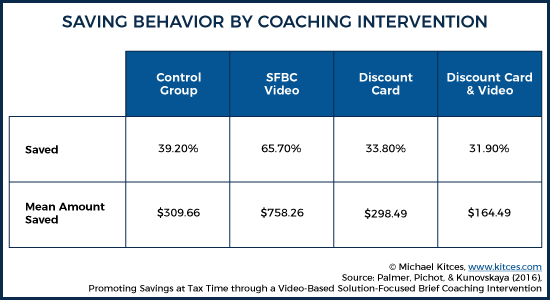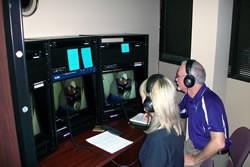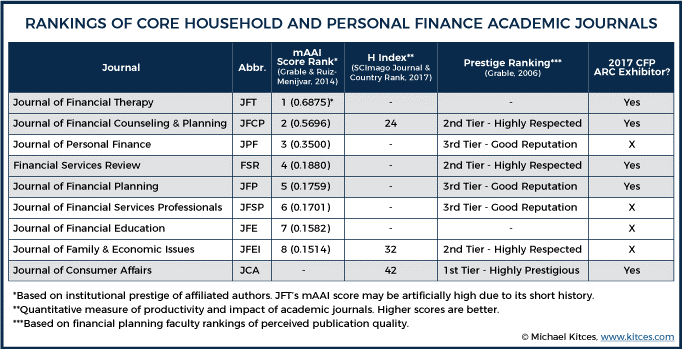Executive Summary
It is widely acknowledged that there is both an ‘art’ and a ‘science’ to financial planning. Technical knowledge – the “science” – is crucial to delivering the technically accurate advice to clients. But the best advice in the world is meaningless if the financial advisor can’t master the “art” of delivering it in a skillful manner – leading a client to actually take action and improve their financial well-being. Yet despite its label as "art", the reality is that how best to deliver financial advice advice can itself be subjected to scientific scrutiny. Which is beginning to happen, with the emergence of several "financial counseling laboratories" in educational institutions across the country.
In this guest post, Derek Tharp – our new Research Associate at Kitces.com, and a Ph.D. candidate in the financial planning program at Kansas State University – examines what a financial counseling laboratory is, and how researchers are using financial counseling laboratories to subject the 'art' of financial planning to scientific investigation.
A financial counseling laboratory is an environment in which financial planning, counseling, or therapy research can be conducted. The space itself is akin to the kind of office with tables and chairs that financial advisors might use to meet with their clients. However, the key feature of a financial counseling lab is that it contains some unobtrusive means of observation, such as one-way mirrors or cameras, allowing the interactions between a financial advisor and their client to be scientifically measured and tested (and sometimes also monitored by students who may be gaining practical observational training, or even engage in the supervised practice of their financial planning skills).
The existence of financial counseling laboratories is important given how conducive they are to conducting highly relevant research for practitioners about how to actually be better financial planners, and get clients to engage their financial advice. In fact, some of this research is already beginning to emerge, delving into topics such as how the physical office environment influences client stress, how coaching techniques can help clients save more, and how measurements of brain activity suggest receiving counseling from an advisor with a CFP designation (relative to a non-credentialed advisor) may actually reduce stress during market declines! In essence, laboratory research – in a financial setting, examining questions relevant to advisors – may soon begin to shape the future of how financial planners interact with their clients!
Advisors who are interested in supporting or assistance with the research process have several options, from getting involved with organizations like the Financial Therapy Association (where many of the Financial Counseling laboratory researchers are engaged), collaborating with researchers themselves on future projects, contributing financially to organizations such as the CFP Board's Center for Financial Planning, or contributing directly to the handful of universities which already have permanent on-campus financial counseling laboratories.
But the bottom line is that, for the first time ever, the "art" of financial planning itself is beginning to be subjected to scientific scrutiny, with the potential to yield important insights into the practice of financial planning, and how advisors can better get clients to actually adopt their advice!
Subjecting The ‘Art’ Of Financial Planning To Scientific Investigation
It is widely accepted that there is both an ‘art’ and a ‘science’ to financial planning. Technical knowledge – the “science” – is crucial to delivering the right advice to clients. But the best advice in the world is meaningless if the financial advisor can’t master the “art” of delivering it in a skillful manner – leading a client to actually take action and improve their financial well-being.
This dynamic is not unique to financial planning. It is exemplified well in the modern Hippocratic Oath, which states, “I will remember that there is art to medicine as well as science, and that warmth, sympathy, and understanding may outweigh the surgeon's knife or the chemist's drug.”
And though it is known that the art and science of financial planning are both important, we actually know surprisingly little about either. This too is not unique to the financial planning profession. Even the field of medicine, which is perceived to be far more ‘scientific’ than financial planning, has had less evidence-based support for both the art and the science of the profession than we likely wish to believe. In a 2016 Freakonomics podcast on “Bad Medicine”, Vinay Prasad, an assistant professor of medicine at Oregon Health & Science University, said:
The reality was that what we were practicing was something called eminence-based medicine. It was where the preponderance of medical practice was driven by really charismatic and thoughtful, probably, to some degree, leaders in medicine. And you know, medical practice was based on bits and scraps of evidence, anecdotes, bias, preconceived notions, and probably a lot psychological traps that we fall into. And largely from the time of Hippocrates and the Romans until maybe even the late Renaissance, medicine was unchanged. It was the same for 1,000 years. Then something remarkable happened which was the first use of controlled clinical trials in medicine.
Particularly when we look at the art of financial planning, “bits and scraps of evidence, anecdotes, bias, preconceived notions, and probably a lot of psychological traps we fall into” likely describes a lot of how we practice as financial planners.
That’s not to disparage financial planners – most of us are just doing our best with the training and information we have available – but the underlying evidence is limited, and therein lies the promise of financial counseling laboratories to radically change our profession for the better. Instead of continuing to rely on dogma and tradition to inform the art of financial planning, controlled clinical trials can subject the art of financial planning to scientific investigation.
What Is A Financial Counseling Lab?
A financial counseling laboratory is an environment in which financial planning, counseling, or therapy research can be conducted – allowing the interactions between a financial advisor and their client to be scientifically measured and tested.
The word “laboratory” typically conjures up images of sterile environments where people in lab coats conduct experiments, but a financial counseling lab typically looks much different. Financial counseling labs tend to be comfortable environments that would be suitable for meeting with a client and giving them financial advice. However, relative to the average financial advisor’s office, a financial counseling lab is probably going to have more of an intimate feel to it. Think more of a therapist’s office rather than a typical financial advisor’s office, perhaps with a small round table or some comfortable chairs for discussion. The image below is an example from the ASPIRE Clinic at the University of Georgia:

Image Source: ASPIRE Clinic at the University of Georgia, image from YouTube video
A key feature of a financial counseling lab is that it contains some unobtrusive means of observation, such as one-way mirrors or cameras. Fundamentally, this is what distinguishes a financial counseling lab from just any other room. Unobtrusive observation is important for not just conducting research and observing participants, but also for monitoring students who may be gaining practical experiencing by giving advice to others within a monitored environment. Here is an example of the Financial Counseling Clinic at Iowa State University:
In the image above, you can see that observation is available through the use of a one-way mirror and microphones. The researcher or instructor can observe the meeting in a manner that is less obtrusive than having someone sitting in the room and taking notes. Additionally, if a student should need help or lose control of a meeting, a professional is available to step in.
Another method of observation is the use of cameras. The image below shows one such setup at the Financial Therapy Clinic at Kansas State University:
Observation at this facility is provided via cameras, which record where the advisor and client are but can be watched in another room. Additionally, recordings can be generated (with client permission, of course!), so that researchers or students can go back and watch the recording in order to gather data or improve their performance.
Biometric data, including measurements of both physiological characteristics (e.g., EEG measurements of brain activity, skin conductance sensors attached to fingers or other parts of the body) and behavioral characteristics (e.g., how we move, speak, or behave), can also be gathered in a laboratory setting.
It is also worth noting that while there are advantages to having a permanent on-campus laboratory, the current state of audio/video technology arguably allows for almost any setting to be turned into an observational laboratory. Further, laboratory style research that doesn’t require recording or live observation (e.g., research based on pre- and post-assessments, without any need to observe or record the intervention being investigated) can be conducted without a permanent laboratory. For instance, while Texas Tech does not have a permanent financial counseling laboratory, they do have an excellent peer financial counseling program called Red to Black, which can get permission from clients to conduct videotaped sessions that can then be reviewed by student coaches for training purposes.
Laboratory Research To Study The “Art” Of Financial Planning
Much of the research currently conducted in financial planning programs at universities is quantitative research based on the use of secondary data sets. For instance, researchers may use data sets to study things such as the relationships between financial knowledge and financial behavior, the characteristics of those who do (or don’t) use financial planners, or associations between things such as financial knowledge and the use of alternative financial services.
While this type of research is incredibly important, from a financial advisor’s perspective, it won’t necessarily provide insights with immediate applications for your business. For instance, while it is important to understand the associations between financial sophistication and financial satisfaction, from a business perspective, there’s not much an advisor can necessarily do with this.
Laboratory research, on the other hand, is conducted in an environment similar to how advisors actually work with clients. Further, laboratory research often examines questions with very practical implications. For instance, researchers may be looking issues such as: how different communication strategies or office environments influence client decision making; how different client segments prefer to interact with an advisor; or what presentation techniques help clients best learn and retain information. For this reason, studies that will likely have the largest impact on the actual practice of financial planning will be coming from laboratories.
That said, there are some significant challenges to conducting laboratory research. First, relative to many other types of labs on a college campus, financial counseling labs simply don’t have the same levels of funding. Second, even when the funding (or professor/grad student labor) is available, it can be really hard to get laboratory research published, particularly given the small sample sizes that are common in laboratory research. Among the core personal finance journals, only the Journal of Financial Therapy is typically interested in publishing studies with small sample sizes and/or experimental designs. Given the amount of work that goes into setting up, conducting, and then writing up the results of an experimental laboratory study, researchers may choose to prioritize their efforts elsewhere if there is limited potential for publication or other professional benefit associated with a project.
While the interest in laboratory research among existing journals has been limited, the CFP Board Center for Financial Planning will be launching a new academic journal later this year which will be open to clinical and experimental studies. Given the Center for Financial Planning’s focus on ensuring that their journal will meet academic criteria for university faculty to achieve tenure and promotion at top business schools, this new journal will create further opportunities and incentives for the production of high quality experimental and clinical research.
Notable Research That Has Come Out Of Financial Counseling Laboratories
While the bulk of existing financial planning research has been on more technical planning topics or has utilized secondary data sets, it’s notable that there are already several financial counseling laboratories in operation today, and many have already published research with relevance for financial advisors.
Client Stress And The Physical Office Environment
One of the most well-known studies to come out of a financial counseling laboratory is a study on client stress and the physical environment of an office (Britt & Grable, 2010).
Based on research conducted at the Financial Therapy Clinic at Kansas State University, researchers found that meeting with clients in a room with a couch and an arm-chair creates less stress than a more typical environment of sitting at chairs around a table.
Given that prior research has found that client stress can reduce the ability to build trust with a client, interfere with client willingness to consider long-term implications of their behavior, and result in overall negative outcomes for a client-advisor relationship, the practicality of such physical office environment studies should be obvious.
In their 2010 article in the AFCPE publication The Standard, Britt and Grable also suggest that other stress reducing modifications that can be made to an office environment may include:
- Add naturalistic features to the office environment, such as plants
- Use neutral wall colors
- Play soft, non-lyrical music in the waiting room
- Minimize physical “barriers” (such as a table) between the client and advisor
Their article also stresses the importance of being observant of client cues of stress (e.g., cold hands can be a direct indication of stress), as well as advisor stress. Stress transference (when a client consciously or unconsciously perceives and experiences an advisor’s stress) can be detrimental to a client-advisor relationship as well. Meditation, deep breathing, walks outside, and reduced caffeine intake prior to a meeting are all steps an advisor can take to reduce the amount of stress they may personally introduce into an office environment.
Helping Clients Actually Implement Financial Planning Recommendations
As most any advisor can attest, knowing what advice to give a client is one thing, but knowing how to get them to actually take that advice can be the real challenge.
In a 2016 study published in the Journal of Financial Therapy, Lance Palmer, a clinical faculty supervisor for the ASPIRE Clinic at the University of Georgia, along with his coauthors Teri Pichot of the Denver Center for Solution-Focused Brief Therapy and Irna Kunovskaya of The Financial Literacy Group, examined how savings could be promoted through the use of solution-focused brief coaching techniques.
In short, solution-focused brief coaching is a collaborative form of coaching that is focused on the future and setting goals to make a client’s situation better, rather than focusing on the past and where the client is struggling. Solution-focused brief coaching utilizes many techniques of solution-focused brief therapy, though with more emphasis on the coaching aspect of the relationship than therapy.
To examine how solution-focused brief coaching techniques can promote savings behavior, participants receiving tax preparation services at a Volunteer Income Tax Assistance (VITA) location were randomly assigned to one of four groups: 1) a group receiving video-based solution-focused brief coaching; 2) a group receiving a discount card incentive; 3) a group receiving both video-based solution-focused brief coaching and a discount card incentive; or 4) a control group. Each client then had an opportunity to save part of their refund, if they had one.
The Interventions
Video-Based Solution-Focused Brief Coaching
The video-based solution-focused brief coaching intervention consisted of a professional therapist serving as a “video coach” to walk the client through a coaching exercise. The video itself was roughly 10 minutes, though the total length of the intervention depended on how long participants took to complete some self-reflection tasks.
The video coaching questions included asking the client the miracle (or fast-forward) question (a question commonly used in SFBT to get the client envisioning a world without a current problem they are facing), scaling questions (questions which are used to assess commitment, confidence, and motivation to change behavior [Archuleta et al., 2015]), next step questions, coping questions, and relationship questions. Participants followed along with a worksheet and the video would pause to allow clients to answer each question, only restarting once the client confirmed they were ready to continue. You can watch the video below:
https://www.youtube.com/watch?v=f5qo3AoMa2U
The specific sections of the video include:
- Welcome and introduction
- Introduction of the video coach as a life coach
- Invitation to think about their desired financial future
- Explain why the video may be helpful
- Provide an analogy the emphasizes the importance of planning for the future
- Fast-forward exercise (worksheet activity)
- Explore current exceptions (worksheet activity)
- Provide a ladder analogy to explain scaling
- Create a clear vision of how things would improve in their desired state
- Explore possible next steps to reach their desired state (worksheet activity)
- Invite the client to discuss their goals and next steps with the tax preparer
The uniformity provided by the video presentation of the therapy session was an advantage of this study. While there certainly other advantages to having a real life therapist provide the intervention, video presentation allows the researchers to be more confident the intervention was more consistent for clients.
Cashless Matching Incentive
The second intervention was referred to as “The 10% Club”. Clients who saved at least 10% of their tax refund into a long-term savings account (e.g., US savings bond, IRAs, or CDs) were offered a discount card to local business as part of a cashless matching incentive. The card providing varying discounts to local businesses (e.g., 10% off, buy one get one free, etc.).
Results
At the end of their session, each client was asked the following questions:
- Did you save part of your refund today?
- How did you save part of your refund today?
- How much of your refund did you save today?
The results strongly supported the efficacy of solution-focused brief-coaching, finding a statistically significant difference in both whether a client saved and how much they saved:

The results for the discount card did not fare as well. Interestingly, the combination of both the discount card and the SFBC was the worst outcome. The researchers suggest this may be the result of student tax preparers not seeing themselves as coaches, and therefore feeling uncomfortable with that intervention and steering participants towards the discount card. Another possibility is that the participants experienced choice overload and were more inclined to do nothing. It is also possible the combination of the discount card and the video created the impression the clients were participating in some type of sales presentation, and therefore experienced greater resistance to both options.
Palmer et al. (2016) suggest that perhaps the most significant result of their study was the fact that coaching that led to higher levels of saving was found to be scalable in the sense that the coaching services do not need to be delivered by a flesh and blood human coach, but instead, can be delivered through a recording. Given that a reported 60 million tax returns were filed in 2012 using H&R Block and TurboTax alone, the power of a scalable solution to help people save more should not be underestimated. And while human financial planners may be essential for some types of coaching and financial behavior change, it doesn’t mean that technology and recordings of humans can’t play a role, too!
Brain Activity And The CFP Designation
Another well-known line of financial planning research conducted in a laboratory is Russell James’ research utilizing fMRI, which is a neuroimaging technique which measures brain activity based on changes in blood flow within the brain. James has examined a number of topics related to neuroscience and financial planning, including brain activation when engaging in charitable bequest decision making, brain activations when choosing and changing financial advisors, and how neuroscience can be applied to a financial planning practice.
In a 2013 study in the Journal of Financial Planning, James utilized fMRI to measure brain activity and found that counseling from an individual with the CFP designation can help calm investors relative to similar counseling from a non-credentialed financial advisor.
The study engaged individuals in a stock market game employing four different investment strategies. After being placed in the fMRI scanner looking at a video screen, participants were given the following prompt:
Next you will play a stock-market game. The participant who accumulates the most money in this game will be paid $250. Instead of picking stocks, you will select among four financial planning firms. These advisers will invest in stocks for you based on one of four strategies. You may change firms at any time, as many times as you like. There is no cost to change firms. The four financial planning firms are (A) The Able Firm, (B) The Baker Firm, (C) The Clark Firm, and (D) The Davis Firm.
The Able Firm follows a TRENDS strategy immediately selling stocks that are falling and buying stocks that are rising. The Baker Firm follows a GROWTH strategy buying stocks in companies that are growing. The Clark Firm follows a VALUE strategy buying “cheap” stocks in companies with a lot of assets but low stock price. All advisers in the Clark firm are Certified Financial Planners. A CFP [certificant] must have years of experience, a college degree with investment coursework, must pass a series of rigorous exams and continually complete ongoing education in investing. The Davis Firm follows an INCOME strategy buying stocks in companies that pay high dividends (income). All advisers in the Davis firm are Certified Financial Planners.
After each round you will see your percentage return (gain or loss) for that round and the overall market return for that round. You may change advisers at any point by clicking on the relevant button: left button/left hand for Able; right button/left hand for Baker; left button/right hand for Clark; right button/right hand for Davis .…
Choose your initial adviser now. You may change at any point by pressing the appropriate button.
Participants went through a series of 36 “market reports” which reported how much the market was up in a given round as well as their specific investments. After the 36th market report, participants received the following message:
For the second half of the game, the adviser firms are (A) The Adams Firm, (B) The Brown Firm, (C) The Cook Firm, and (D) the Dale Firm. All firm strategies are as described previously for TRENDS, GROWTH, VALUE, and INCOME. All advisers in the Adams Firm and the Brown Firm are Certified Financial Planners. Choose your initial adviser now.
This continued for 36 more market reports, at which point the game came to an end. In the first round, all participants were given “flat” market returns for the first 12 reports (0.5% - 3.0%), high for the next 12 reports (10% - 20%), and low for the final 12 reports (-10% to -20%). A similar structure was used for the second half of the game, except returns were presented as high, low, and then flat. The selection of an advisor did not impact returns, and all advisors either did better or worse than the market by 1% - 5% based on a pre-determined sequence.
On average, participants selected CFP advisors 62.5% percent of the time, and that rate was similar during both periods of market under- and over-performance. Advisor switching was more common during periods of poor performance (nearly 75% of all switches occurred during poor performance).
Statistically significant brain activations were found when using a non-CFP versus a CFP during an under-performing market. Russell notes that activation within the anterior cingulate cortex is particularly notable given that it is a region that has been found to be associated with error detection, and particularly error detection within another person. In other words, the fMRI results when a non-CFP experiences under-performance are consistent with the type of brain activity that occurs when we question the errors of others, suggesting that participants may be more questioning of non-CFPs than CFPs during times of poor market performance.
How Financial Planners And Academics Can Better Collaborate In Laboratory Research
The New CFP Board Journal And The Financial Therapy Association (FTA)
Laboratory research will continue to yield important insights on the practice of financial planning. However, as noted previously, there are some challenges related to both funding and getting laboratory research published. While there isn’t much advisors can do to help out with the publishing issue (though contributing to the Center for Financial Planning’s to support its new journal is certainly an option), one way advisors can get more involved is joining and engaging with the Financial Therapy Association.
In practice, the Financial Therapy Association has become the central organization bringing together those conducting research in financial counseling laboratories. Participation gives advisors the opportunity to help generate new research ideas, give feedback to researchers on their studies (as most will gladly welcome feedback to make their research more practical!), and help ensure academics aren’t too isolated from the needs of practitioners (the classic “academics in their ivory towers” concern). And for interested advisors, there may even be opportunities to collaborate on research as well, such as sharing (anonymized) client data or even permitting researchers to do “field work” in the advisor’s real financial planning environment (though still subject to Institutional Review Board [IRB] requirements!).
In addition to opportunities for collaboration, advisors who join the FTA also receive access to the Journal of Financial Therapy (which is the journal most open to clinical and experimental studies that relate to everyday financial planning practice). And, of course, joining also helps provide financial support, which in turn helps the organization grow and continue to build its reach.
Provide Financial Support To Financial Counseling Labs
Another meaningful way to help out with research is through funding. In fact, given the relative youth of financial planning as an academic discipline, a little bit of funding can actually go a very long way. Advisors would likely be surprised how far even a few thousand dollars can go towards funding research that literally shapes the future of the profession.
For advisors who are interested in funding research, the best place to start would be by seeking out labs or clinics that are conducting quality research, and then contacting a lab/program director to begin the conversation. A starting list of programs with on-campus financial counseling labs include:
- University of Georgia
- ASPIRE Clinic: Joe Goetz and Lance Palmer, Financial Planning Clinical Supervisors
- Financial Planning Performance Laboratory: John Grable, Director
- Iowa State University
- Financial Counseling Clinic: Jonathan Fox, Director
- Kansas State University
- Financial Therapy Clinic: Kristy Archuleta, Director
- University of Missouri:
- Office for Financial Success: Marco Pantoja, Interim-Director
While not an exhaustive list, other programs which may not have a permanent financial counseling laboratories but do have strong financial planning programs and research faculty include Texas Tech University, The American College, Ohio State University, University of Alabama, and Utah Valley University.
Ultimately, laboratory research will continue to be an important source of new insight into the financial planning profession – allowing us to subject the “art” of financial planning to scientific investigation. Practitioners have a big role to play in the continuing development of financial planning research, and there are many opportunities to get involved. Whether it is by engaging in the literature and applying it in your practice (thereby helping to build the culture of an evidence-based profession), actually getting involved in the research and collaborating with researchers, or providing funding that can lead to new insights and the development of research agendas – both practitioners and researchers have a unique opportunity to continue shaping the future of the financial planning profession going forward.
So what do you think? Will financial counseling laboratories play an important role in the development of financial planning as a profession? Have you ever been interested in getting involved with research? How do you think practitioners can best help researchers? Please share your thoughts in the comments below!








Thanks for writing about this important subject. Yes, financial planning research is inadequate now. Lots of anecdotal evidence and opinions given, with not a lot of scholarly research. But that’s changing. Getting the findings of these studies out there is also important, including practical applications for professionals and those they work with. As a collaborative team (Dr. Carrie West, Schreiner University; Dr. John Grable, University of Georgia; Dr. Linda Leitz, It’s Not Just Money; Carolyn C. Moor, Modern Widows Club nonprofit; Michele Neff Hernandez, Soaring Spirits International nonprofit; Susan Bradley, The Sudden Money® Institute; and Dr. Kathleen M. Rehl, Rehl Wealth Collaborations) we published our second research study focused on widows and money in the May issue of the Journal of Financial Service Professionals. One of our primary findings is summarized in the graphic below. More articles will follow in other professional and popular magazines and blogs. We’re also sharing our research findings at financial conferences. I appreciate your encouragement for more scholarly research! https://uploads.disquscdn.com/images/9e6703e49fe5f5bc2f104df6c46fafe30838d725f48667d28f2fcd2e4fddb056.jpg
Thanks for sharing, Kathleen! I look forward to reading the additional articles as they come out.